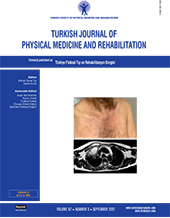Comparison of osteoporotic fracture risk in surgical and natural menopausal patients
2 Department of Obstetrics and Gynecology, University of Health Sciences, Ankara Training and Research Hospital, Ankara, Turkey
3 Department of Obstetrics and Gynecology, University of Health Sciences, Ankara City Hospital, Ankara, Turkey
4 Department of Obstetrics and Gynecology, University of Health Sciences, Etlik Zübeyde Hanım Maternity and Women’s Health Hospital Research Hospital, Ankara, Turkey DOI : 10.5606/tftrd.2021.5918 Objectives: This study aims to compare the fracture risk calculated with Fracture Risk Assessment Tool (FRAX®) in patients with natural and surgical menopause.
Patients and methods: Between April 2019 and July 2019, 285 postmenopausal patients (mean age 57.3 years; range, 40 to 78 years) who were admitted to the menopause clinic were enrolled in this prospective cross-sectional study. Of these, 220 were in natural menopause and 65 were in surgical menopause. Demographic data, medical history, and International Physical Activity Questionnaire scores were collected through face-to-face interviews with the patients. Femoral neck and lumbar vertebrae (L1-L4) T-scores were evaluated using dual-energy X-ray absorptiometry. Fragility fracture risk was assessed using FRAX®.
Results: The groups were similar in terms of age, body mass index, duration of menopause, smoking, alcohol use, and history of fracture (p>0.05). The risk of major osteoporotic fracture and hip fracture calculated without adding bone mineral density (BMD) was similar between groups (p=0.417 and p=0.234). The risk of hip fracture calculated with the addition of BMD was higher in natural menopause patients (p=0.023). Lumbar vertebrae T-scores were similar between two groups regardless of age; femoral neck T-scores were higher in surgical menopause (T-score=-0.8) than natural menopause group (T-score=-1.25) aged under 60 years, whereas this difference disappeared after 60 years of age.
Conclusion: In our study, the fracture risk and the severity of osteoporosis were not different in surgical menopausal patients compared to the natural menopausal patients. Hip fracture risk calculated using BMD was lower in patients under 50 years of age in surgical menopausal patients. However, the fracture risks were similar in both groups after 50 years of age.
Keywords : Fracture risk assessment tool, menopause, osteoporosis, osteoporotic fractures

















